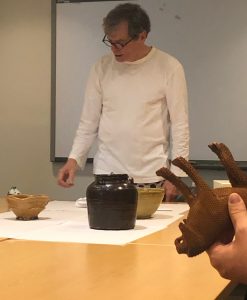|
|

|
|
|
|

Pop-Up Class III
In this pop-up class, held on three successive Wednesdays in BGC’s Object Lab, Richard Tuttle will talk about his collection. In the first class, he will present the objects, essentially giving them to the students. In the second, he will locate the objects by naming collections and institutions where they also may be found. In the third, he will release the objects by analyzing how they appear and affect a definition of material culture, enlarging the notion of human development to the treatment of each other in a society.
Wednesday, October 30, 12:15-1:15 pm | Object Lab
RSVP: alec.newell@bgc.bard.edu
|
|
Richard Tuttle is an influential contemporary American artist. Working across media and disciplines, his works are characterized by their thoughtful subtlety. Tuttle’s compositions are formed through the carefully considered relationships between form, color, and material, generating a universe of intimate connections bridging the gaps between art, life, and thought. “If you’re going to be a visual artist, then there has to be something in the work that accounts for the possibility of the invisible, the opposite of the visual experience,” he has said. “A painting or a sculpture really exists somewhere between itself, what it is, and what it is not—you know, the very thing. And how the artist engineers or manages that is the question.” His aesthetic direction is often discussed within the context of Post-Minimalism, and his contributions to the contemporary art sphere are extensive. Tuttle has been celebrated by countless exhibitions and institutions, including his inclusion in numerous Venice Biennale, documenta, and Whitney Biennial exhibitions, and a major retrospective at the San Francisco Museum of Modern Art. Tuttle lives and works throughout the United States.
Tuttle and his wife, poet Mei-mei Berssenbrugge, have assembled an extensive collection of objects spanning time periods, continents, and styles. It is a collection based on personal connections and resonances between the objects and these two accomplished artists. They have generously given a selection of these objects to BGC for the benefit of students and scholars.
|
|
COPY AND PASTE CODE BELOW TO MAILCHIMP
|